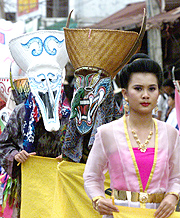 |
| Thais wear
masks representing the laughing spirits of the dead springing back
to life at the annual Phi Ta Khon festival in Dan Sai, 520
kilometres northeast of Bangkok near the Laos border June 24, 2001.
The event is one of Thailand's most colourful festivals in which the
spirits of the dead spring back to life as fun-loving ghosts dancing
to traditional tunes in a centuries-old ritual believed by locals as
a means of driving away bad fortune.
| Everyone loves a
good ghost story. The gruesome, the spiritual and the supernatural arouse
an instinctive curiosity in all of us. In the west, ghostly fervor reaches
a peak with Halloween on October 31. In Thailand, the spirit-world comes
closest to us in June with the Phi Ta Khon festival, an event filled with
fun, mischief and of course, a touch of the unknown.
The Phi Ta Khon Festival is quite unique to Thailand and unrivalled by
any other ghost festival. Held in Dan Sai district of Loei province, about
450 km north of Bangkok, Phi Ta Khon is part of a Buddhist merit-making
holiday known locally as 'Bun Pha Ves.' The precise origin of Phi Ta Khon
is unclear. But it is believed that the roots of the festival revolve
around an important tale of the Buddha's last life, before he reached
nirvana.
According to Buddhist folklore, the Buddha-to-be was born as Prince
Vessandorn, a generous man who gave freely to the people. One day, he gave
away a white elephant, a royal creature, revered as a symbol of rain. The
townspeople were so angry for fear of drought and famine, that they
banished the prince into exile.
The prince left the village for a very long journey. Finally, the king
and the people got over their anger and recalled him to the city. When he
eventually returned, his people were overjoyed. They welcomed him back
with a celebration so loud that even the dead were awakened from their
slumbers to join in the festivities.
Phi Ta Khon is held with the arrival of the sixth or seventh lunar
month. Young male villagers prepare their ghostly attire and masks, while
children roam around town playing tricks. Sheets or blankets are sewn
together to look like shrouds while traditional wooden bamboo containers
used to store sticky rice (huad), are creatively fashioned into bizarre
hats. The huge masks are carved from the bases of coconut trees. The
spirit masks are the integral part of the celebrations, which last for
three consecutive days.
The first day is marked by a masked procession, accompanied by
rejoicing, music and dancing. On the second day, the villagers dance their
way to the temple and fire off bamboo rockets to signal the end of the
procession. Along the way, they tease onlookers as they accompany a sacred
image of the Buddha through the village streets. Monks recite the story of
the Buddha's last incarnation before attaining enlightenment.
The festival organizers also hold contests for the best masks, costumes
and dancers, and plaques are awarded to the winners in each age group. The
most popular event is the dancing contest among those dressed up as
ghosts.
On the last day of the event, the villagers gather at the local temple,
Wat Ponchai, to listen to the message of the thirteen sermons of the Lord
Buddha, recited by the local monks. The ghost dancers then put away their
ghostly masks and costumes for another year, return to the paddy fields
and continue to earn their living with the onset of the new crop
season. |